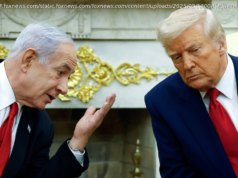Donald Trump is navigating a new nuclear era—and fashioning a new approach.
“Remind me of Secretary Kerry’s visit to Tehran, or the time that Obama met with” Iranian President Hassan Rouhani, John Delury, a Korea expert at Yonsei University, challenged me when we got together in Seoul in May. I couldn’t, because those things never happened. And that was precisely Delury’s point.
What Donald Trump is doing with North Korea is in fact “bolder” than what Barack Obama did with Iran, he argued. Delury disagreed with Trump’s decision to withdraw the U. S. from the nuclear agreement with Iran, and acknowledged that America’s relations with Iran are even more toxic than its relations with North Korea because Washington and Tehran are on opposing sides of conflicts across the Middle East. Still, he maintained that Obama’s “complicated, technical” deal may have been “too focused” on constraining Iran’s nuclear capabilities. “It wasn’t a deep political settlement,” he explained, whereas “what I see Trump working on with Kim Jong Un is … a fundamental transformation of the relationship.”
And what Trump is facing is nothing less than a new nuclear age, when the strategies that kept the world safe during the Cold War may no longer apply. In the words of James Holmes of the U. S. Naval War College, “there are more nuclear-weapon states” now than during the Cold War, “they’re of different shapes and sizes, and they’re on different trajectories.” If the fundamental question now is the same as it was during the Cold War—how do you keep the world’s deadliest weapons from destroying the world?—the context is entirely different, and maybe that means the approach must be as well.
“I think Trump gets it,” Delury told me. Fundamental transformation is “the way to get progress with North Korea.… We have so trained ourselves to… treat North Korea as a question of missile and nuclear capabilities. We’re almost Pavlovian at this point: They launch a missile and we salivate. That’s all we understand the problem to be.” But the problem is decades of hostility deeper than that.
As Trump himself has said of his nuclear summit this week in Singapore with Kim Jong Un: “We’re going to get to know a lot of people that our country never got to know.… There’s been a lot of… hatred between countries.… At a minimum, we’ll start with, perhaps, a good relationship. And that’s something that’s very important toward the ultimate making of a deal.”
Trump has executed a head-spinning shift in recent months, going from threatening North Korea with total destruction and the harshest sanctions in history, to courting the North with visions of economic partnership and future visits by Kim Jong Un to the White House. He withdrew from the nuclear deal with Iran while simultaneously seeking a nuclear deal with North Korea. All this may seem like inexplicable moves by a volatile president intent on demonstrating that he’s a better dealmaker than his predecessors. And maybe, to a considerable extent, that’s what they are.
But in a broader sense, the moves are quite explicable. Trump, just like many other policymakers these days, is casting about for a solution to a problem that has grown more vexing over the course of what some scholars refer to as the “second nuclear age.” And he doesn’t appear to have made up his mind yet about the best way to navigate it. “Maximum pressure [against North Korea] is absolutely in effect,” he said ahead of the Singapore summit. “We don’t use the term anymore because we’re going into a friendly negotiation. Perhaps after that negotiation I will be using it again.”
Though there may be more nuclear-weapons states now than during the Cold War, there are far fewer nuclear weapons in the world today, Holmes noted. At the same time, however, the “geometry” of nuclear deterrence is “far more complex and harder to manage” because the “symmetrical” arms race between the United States and the Soviet Union, and the bipolar deterrence that undergirded it, is no longer the central dynamic. Hence why H. R. McMaster, Trump’s former national-security adviser, once declared that if North Korea were to become a full-fledged nuclear power—with the capacity to launch nuclear missiles anywhere in the world, share nuclear weapons and technology with other states and non-state actors, and scare neighbors into obtaining nukes of their own—it “would be the most destabilizing development… in the post-World War II period.”
In the case of the North Korea summit, “President Trump places great faith in his own ability to relate to others on a personal basis, and so it does seem like he wants to bolster the political relationship [with Kim] and then trust that will lead to arms control,” Holmes told me. “Politics leads, international law lags. We appear to be about to put this idea to the test.”
Jeffrey Lewis, the director of the East Asia Nonproliferation Program at the Middlebury Institute of International Studies at Monterey, is less confident than Delury that Trump “gets it” at a strategic level. In becoming the first American president to meet the leader of North Korea, Lewis argued, Trump is simply being “transactional.… He wants the photo just as badly as Kim Jong Un. He wants the foreign-policy win.”
But Lewis added that the far-reaching deal the Trump administration appears to be contemplating may be fitting for the new nuclear era. Coercive tools for stopping the spread of nuclear weapons aren’t nearly as powerful now as they once were. The more promising tools, he said, “are persuasive in nature.” And maybe they look something like the options the Trump administration has floated ahead of the Singapore summit—transformative political, security, and economic concessions such as a formal declaration to end the Korean War; a flood of American investment; and eventually a peace treaty and the normalization of diplomatic relations with North Korea in exchange for North Korea dismantling its nuclear-weapons program.
When it comes to efforts to control and curb the proliferation of nuclear weapons, Lewis argues, the “coercion era” is ending. We’re now in the “asking nicely” era. And Donald Trump, in Singapore, for a day at least, will essentially be asking nicely.
In the 1970s and ’80s, economic sanctions and national laws prohibiting the export of nuclear-related technologies were effective because most countries didn’t have a sufficient industrial and technological base to build nuclear arsenals on their own, Lewis said. But they’re far less so today, when nuclear technologies are “archaic” and it therefore isn’t as difficult for aspiring nuclear states to develop native programs. (“North Korea is not the world’s great industrial power,” he noted.) And since the barriers to entering the nuclear club are now lower, it’s also less credible for the United States to threaten war with every country capable of clearing the hurdle. Is the U. S., already traumatized by two long wars in Afghanistan and Iraq, really going to invade both Iran and North Korea to prevent them from acquiring nuclear weapons? Lewis asked.
U. S. officials may argue that it was Trump’s sanctions and talk of military action that forced Kim Jong Un to negotiate, but Lewis believes it was Kim Jong Un’s declared completion of his nuclear program last fall that proved decisive. As Lewis sees it, it was the failure of Trump’s “maximum pressure” campaign against North Korea, not the campaign’s success, that has motivated the president to pivot to the polar opposite approach: a campaign of maximum engagement with Kim.
The Obama administration tended to credit sanctions with paving the way for the Iran deal, but Lewis thinks the agreement was really a product of the administration dropping a number of demands and asking nicely: The United States, for example, let Iran keep certain nuclear facilities and continue engaging in some limited enrichment activities.






